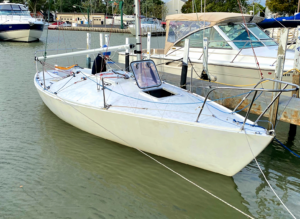Boats break a lot. Or more accurately, things on boats break a lot. The hull itself is pretty solid unless you run into things. But a salt water sailboat lives in a hostile, corrosive environment its whole life. Unless it’s stored for the winter, in which case it’s subject to freezing, moisture and condensation, invasive pests, rain, and ice. And when we use them, they’re subject to crazy tilting, vibration, and pounding while we apply lots of stress and loads from different directions.
So things are always chafing, shaking apart, corroding, freezing, seizing, or just plain failing. Fortunately, with a small bag of tools and a bit of knowledge, you can make a lot of quick fixes to keep you out for the weekend or racing around the cans until you can get home safely.
Common Boat Failures
There are a few broad categories of boat failures, which range from the annoying to the catastrophic. You can fix of the worst-seeming with the same basic tools, though a few require some special gear.
Some of the more common repairs you can sometimes fix quickly include:
- Engines that won’t start
- Overheating engines
- Fuel system issues
- Broken belts
- Electrical failures
- Clogged heads
- Shifting and steering failure
- Loose cabinetry, doors, and fixtures.
- Dead batteries
- Stuck or frozen fittings, handles, cables, or other moving bits.
While we won’t get into detailed repair tactics, we’ll help you put together a basic tool bag to give you a fighting chance. We’re talking about unpowered hand tools in this article, power tools are a different topic. But we’ll throw in a few goos, glues, and sealants that are helpful in a pinch.
Of course, manage expectations; while can replace a worn impeller with a screwdriver or a wrench, you cannot always sort out more serious mechanical issues.
Core Tools
Every tool bag needs an assortment of the following in a few sizes. For wrenches and sockets, figure out if your boat uses primarily metric or SAE (English) measurements. Boats or components built outside the U.S. will often use metric, but you may end up needing both on your boat. There are several good “boat tool kits” on the market that have most of these tools. Just be careful of the brand and quality of the choices – you want good quality, rust-resistant tools.
- Wrenches. You can get combination wrenches with an open end, and a closed (“box”) end. Or to save weight and reduce the number of wrenches, you can get double ended open wrenches with different sizes on each end. The most important ranges are the mid-sized, from 3/8″ up to about 3/4″, or 8mm through 18mm. You will use these for most engine related and mechanical problems, like replacing belts.
- Adjustable wrench. While these are often annoying because they can off nuts, they’re handy when you don’t know the size you need. Or when you need a second wrench at the same time and you only have one in the right size, or you don’t have the exact sized wrench on board. An adjustable is not great as your only wrench, but works well for some things.
- Vice grips. These are great to pinch things closed, hold them in position, or even act as a short term handle.
- Screwdrivers. Have at least one Phillips head and one slotted head screwdriver in a common size like #2. Having a couple of sizes is better, if you can afford the weight. Most of your cabinetry and woodwork uses screws, you’ll need them for hose clamps, and some impeller covers use slotted screws. If your boat uses any less common screws like Robertson or Torx, keep drivers on hand for those.
- Hex keys (or Allan Wrenches). You will fund surprise hex nuts everywhere, so get SAE and Metric as needed. Avoid the “all in one” sets where the keys that fold out like a pocket knife, unless they are easily disassembled. These can be hard to get into tight spaces.
- Precision screwdrivers. Not mandatory, but these are handy for opening battery compartments on small electronics and fixing eyeglasses.
- Hammers. Avoid a claw hammer unless you’re doing woodwork. But a dead blow hammer, a ball-peen hammer, or a rubber mallet are all excellent when something is stuck and needs a little extra convincing.
- Pliers. At least one pair of needle-nose pliers is a must. Also useful are cutting and lineman pliers. Finally, a channel-lock plier will give you a grip on larger things, like LPG tank connections and fittings and large pins.
- Heat gun/mini torch. A heat gun is only good offshore if you have power to run it, but there are smaller mini-torches that work off butane or even lighters that will do some of the same work, albeit less efficiently. Useful for loosening stuck hoses or softening new ones, and melting heat-shrink in electrical repairs.
- Socket set. If you’ve got the space, a 3/8″ socket set is a very versatile tool if you have to take things apart. Some nuts and bolt heads aren’t accessible by hand wrenches, but a socket on an extension might get right in there. If you have an outboard, a 1/4″ drive is handy if you have to take apart the carburetor. And make sure you have a spark plug socket.
Electrical Tools
Working with 12V electricity takes a little understanding, and it’s not for everyone. But if you want to fix a wonky light or failed pump, here are a few items to put in the bag to help.
- Multimeter. Even an inexpensive multimeter can help you sort minor electrical problems like blown lightbulbs or failed running lights.
- Wire crimper and stripper. Many electrical failures are from bad connections and joins in the wiring. If you have to make a connection to repair a failure, a solid, clean crimp is the best way to do it.
- A variety of heat-shrink terminal fittings in a range of sizes and terminal hardware will help you with repairs.
Consumables
There are several products that aren’t exactly tools, but are handy for quick repairs. A small bottle, tube, or assortment of these can often help.
- An assortment of stainless steel nuts, bolts and washers in a few common sizes. Screws are less commonly needed, but should be stainless.
- WD-40 or other lubricant to keep things moving.
- Corrosion-X is and Boeshield T-9 are both excellent at penetrating corroded fittings to free them up, and provides a measure of protection against more corrosion. Corrosion-X is a little better penetrant, and T-9 leaves a protective, lubricating coating.
- J-B Weld is a versatile two-part epoxy that is heat resistant and can repair small pinholes and leaks in metal and other materials, even where there is heating. There are a number of products like this suitable for the marine environment from J-B and other brands, and some may prefer a putty-stick instead.
- Screw-Grab helps screwdrivers get bit in worn, partially stripped, or soft screw heads. It can also be used on worn bolt heads to help wrenches.
- Self-annealing Tape can temporarily patch holes in hoses, cover exposed wiring, and create waterproof seals.
- Small tube of fast curing sealant, like 3M 4200 or GOOP. Sometimes, you just have to stop a leak.
- Bronze wool, for cleaning wiring and electrical fittings. Sandpaper can do in a pinch, but do not use steel wool as it leaves flecks that rust.
- Seizing wire is not only good for seizing shackles, but you can use it to make quick physical connections to hold things in position to stop chafe or temporarily fix something. Wire ties can also do this.
Spares, Spares, Spares
All the tools in the world won’t help you if a component fails outright and you don’t have a spare. Overheating engines, for example, are usually caused by broker impeller blades. Your tools will get you to the impeller, but if you can’t replace it you can’t make the fix.
All boats – even race boats fight to cut weight – should carry at least one spare of a few key parts. You don’t need backup starters of water pumps for most coastal cruising, but those aren’t the things that fail most often.
Spares to carry in every kit include:
- An impeller for the primary engine (and generator if there is one).
- One of every belt on the engine.
- A spare element for the primary fuel filter and a spare secondary filter.
- A quart of engine oil.
- Spark plugs (for outboards and as engines).
- Bulb for running lights (if they aren’t LED).
- Commonly used fuses.
Bonus Recommendation: Knowledge
All the tools in the world don’t do you any good at all if you don’t know how or where to use them. There are few books that cover almost everything you need to know better than Nigel Calder’s Boatowner’s Mechanical and Electrical Manual. This book is an indispensable tool on for anyone with a boat more complex than a dinghy and makes an excellent gift for any sailors in your life.
And for the weight conscious racers – it’s available in eBook format.

